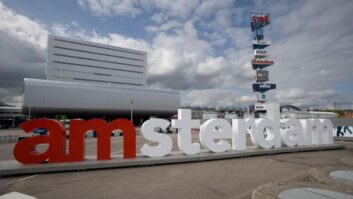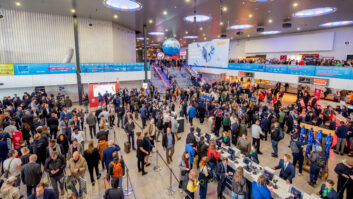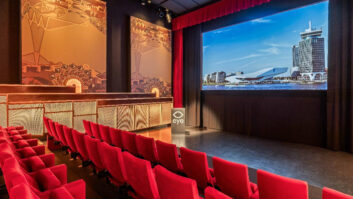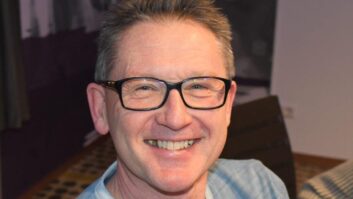Strokes of genius. The Bosbaan Rowing Course combines municipal pride, sporting excellence, historical urban landscaping and a brand new digital sound system. Phil Ward sticks his oar in.
Rowing is taken very seriously here. What was once a pioneering exercise in artificial woods and lakes for the relaxing burghers of Amsterdam is now a state-of-the-art international championship course for the sport that made Steve Redgrave famous. Its refurbishment, including a public address system of the highest technology, comes at a time when the International Rowing Federation has revived the annual European Rowing Championship after a hiatus of 34 years.
The course, opened in 1937, is 2.2km long and in 2003 was widened to eight lanes, serving the local community every bit as much as the aspirant sporting elite. On some occasions the audio system is expected to dovetail to broadcast requirements of both radio and TV, providing live commentary and reporting, while also serving DJ sets and background music. But events of any scale here demand clear and accurate crowd communications, commercial messages and VA, alongside discreet communications between various stations for all those in charge.
These stations are located at the start tower, the boating house and two sets of access points at the finish tower, all connected by CobraNet over fibre optics. It may seem highly sophisticated for a simple stretch of water but the events that take place here create a huge number of different inputs and outputs.
There are microphones everywhere, not only in the buildings but outside along the course, some wireless, together with musical sources on CD and Flash card – some of which take output for recording as well. Then add in the various third-party inputs and wireless intercom, and you have a supremely audio-sensitive site.
Zoned output
The system outputs to several different loudspeaker zones, as well as feeding headset monitoring and recording/broadcast channels. At the centre of it is a Yamaha DME64N mix engine, located at the finish tower and interfaced via custom PC, VLAN and Yamaha control panels. These faders and switches control the DME64N via GPIOs and enable access to the software for levels, mute functions and general-purpose status monitoring.
One of two Yamaha DME4i/o-C satellite units is at the start tower, handling local I/O such as starting signals and competitor instructions. The other is at the boating house with a similar I/O brief but with special duties relating to non-public communications – this is where the boats and their teams are prepared and briefed.
The PA is a prestigious Dutch outing for Paris-based APG, which has supplied bracketed clusters of MC216, MC24 and SC20 loudspeakers. The latter is a long-range array model, described by system designer Eric Mattijsen as having “amazing clarity, throw and directness, even after 100m”. Mattijsen’s company Audio Electronics Mattijsen (AEM) handled the installation which, typically for an open-air public space, had to balance adequate coverage with environmental noise constraints.
“The biggest challenge was to have a high level of audio quality and enough SPL in the public areas, but without audio spill to the surrounding habitat,” Mattijsen says.
“People living close by had complained in the past about sound pollution during big events. The other big challenge was to distribute real-time, high-quality audio and communications over three different locations over 2km apart. We needed a highly focused loudspeaker, and APG let us try out the SC20 on site: we were amazed by its productivity, clarity, speech intelligibility and throw, even against the wind.”
“The key to it is the digital network,” he continues. “The level of control this gives you is unprecedented, with everything transferred through the DME units from analogue audio to control data. You can log into the system and see the entire signal flow, all the I/O, all the general-purpose I/Os, and the status of your CobraNet network. Nothing is summed; every single input and output is available down to amplifier level. For example, one mic signal at the boating house can become, via the network, audible at the start tower – which is more than 2km away.
“The resulting matrix is able to manage every zone very exactly, so much so that Amsterdam City Council has confirmed that there have been no complaints at any event since this system went online. Over the years this has become more of a built-up area, so this was one of the most important criteria when the upgrade was planned.”
Quick turnaround
The installation took just three weeks on site, following a lengthy period of consultation and planning. In October 2008 the first step was taken to replace a sound system that had been in use for over 20 years: the ground was broken for the fibre-optic network needed to provide digital audio and control connections between three different, but related, locations over a 2.5km stretch.
After a winter break AEM’s technical department completed the process: placing all the loudspeaker poles, loading all the racks, programming the software and then installing the loudspeakers and all other cables, remotes and wireless mic positions.
The rigging system was customised in close consultation with APG’s own engineers, and treated in expectation of remaining reliably in place and in use for at least 10 years. “Bear in mind that the loudspeakers are outdoors, 8m up and in the full face of the elements – wind, rain and sun,” Mattijsen points out.
“A very high grade of steel is used throughout to make the brackets and mounting systems, maintaining at the same time maximum flexibility of aim angle for the loudspeakers but also an absolutely secure fixture. On top of this all of the loudspeakers were delivered with the special, all-weather ‘tropical’ treatment developed by APG. It’s a method of ensuring that all parts of the loudspeaker can handle all of the elements without losing audio quality or physical reliability.”
In a sport where physical reliability comes pretty high, to say the least, AEM’s Yamaha- and APG-dominated solution would seem to pulling all the right strokes.







